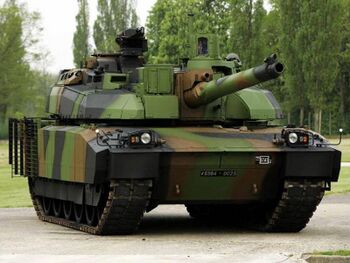Strv 125
| Stridsvagn 125 Puma | |
|---|---|
 Acrean Strv 125A | |
| Type | Main Battle Tank |
| Place of origin | |
| Service history | |
| In service | 1992-Present |
| Used by | |
| Production history | |
| Designer | Estocq Systèmes de Défense SARL Landrut Landsystemet GmbH Landsverk AG Kobalt-Zeiss GmbH & Co KG Thyssen AB |
| Designed | 1989-1992 |
| Manufacturer | Estocq Systèmes de Défense SARL Landrut Landsystemet GmbH |
| Produced | 1992-2005 |
| Specifications | |
| Weight | 54 tonnes |
| Length | 6.88 metres (hull) |
| Width | 3.60 metres |
| Height | 2.53 metres |
| Crew | 3 |
Main armament | KvK M165 120mm smoothbore gun |
Secondary armament | Various Top-Mounted 6.8mm and 12.7mm machine guns |
| Engine | Thyssen MTU MFH1-80A hyperbar diesel 1193,12kw (1600 hp) |
| Power/weight | 20.9 kw/t (28 hp/t) |
| Transmission | Thyssen ML500 Automatic Transmission |
| Suspension | Hydropneumatic suspension |
Operational range | 550 km |
| Speed | 75 km/h (Road) ~55 km/h (Cross-Country) |
The Stridsvagn 125 Puma is a main battle tank developed by Estocq Systèmes de Défense SARL and Landrut Landsystemet GmbH in the late 1980s.
History
Development
Design
Armament
The M165 gun which arms the Strv 125 is a derivative of the earlier M161 which equipped the Strv 124, and an immediate predecessor to the M171 which armed later Strv 124 variants. The barrel was lengthened to 52 calibres over the M161's 44 calibres; this was later increased to 55 calibres for the M171. Additionally, a slightly larger diameter single-piece thermal sleeve replaced the segmented thermal sleeve present on the M161 and M171, and uses a compressed air fume extraction system.
The Strv 125 utilises an autloader fitted with an automatic magazine in the turret bustle, a predecessor to the the automatic magazine fitted to Landrut's proposed compact autoloader which is fitted to "V"-variant Strv 124s and the autoloader equipped on the Strv 126. However, due to the smaller turret bustle on the Strv 125, it is only able to hold 26 rounds in its magazine compared to the Strv 124V's 34 rounds, and the Strv 126's 38 rounds.
Mobility
The Strv 125 utilises a hyperbar system, in which the primary diesel engine's turbocharger is replaced with a gas turbine which acts both as the engine's supercharger, and also being able to function as an auxiliary power unit. Engine exhaust which is redirected to the top of the vehicle is cooled to reduce the thermal signature, and the hull design integrates other materials to reduce the engine's thermal signature.
The suspension system as originally designed technically allows independent control of each road wheel, however this capability was considered unnecessary and so the final design implemented on Strv 125 is a simplified hydropneumatic suspension system akin to the Strv 124's, and simply allows the tank to change the angle of the hull relative to the terrain. Leaning the hull forward or back to gain gun depression and elevation, or tilting the hull on sloped terrain to level the gun were features well-regarded by crews during testing and so this feature taken from the Strv 124's hyrdopneumatic suspension were maintained. Likewise, the overall height of the tank can be adjusted, although the tank is either limited in movement or forced to be stationary when not at standard ride height depending on the attitude. An automatic track tensioning system was tested and implemented on some early prototypes, however added complexity, cost, and maintenance required by this system was not considered efficient and so the same simple tensioning system of the Strv 124 was retained.